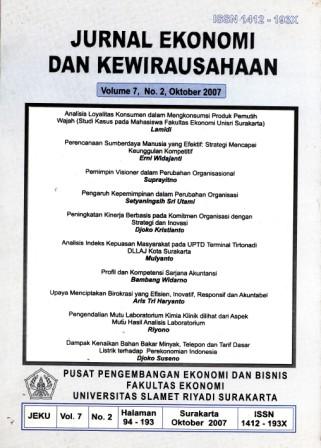PENGENDALIAN MUTU LABORATORIUM KIMIA KLINIK DILIHAT DARI ASPEK MUTU HASIL ANALISIS LABORATORIUM
Abstract
Abstract
This study was aimed at learning the quality of laboratory analysis result, accuracy and precision of laboratory analysis and how the relationship of analytical internal quality control with accuracy and precision of laboratory analysis result. The measurement tools were questionnaires and gold standard. The analysis used t-test, Variance Index Score (VIS) and Spearman’s Rank Correlation.
Data collected from 30 respondents and 360 sample (precinorm ‘U) on 9 laboratory hospital of Sub-Province Sragen and result of research indicate that (1) there was relationship between the score of analytical quality control and that of laboratory analysis result which tend to be lower. (2) The score of chemical laboratory quality control of private clinics Sub-Province Sragen in the pre-analytical, analytical and post-analytical stages were included in the category of good. The accuracy and precision of laboratory analysis result was better at the metabolite check up than that of enzyme (SGPT) (3) There was no relationship between the score of analytical quality control and precision laboratory analysis result, both for metabolite and enzyme types (4) The clinical laboratory with poor category have relatively many patients and analysis staff and one of the laboratories had a staff in charge with clinical pathology background.
Keywords: quality, accuracy and precision, analysis result quality, laboratory, clinical chemistry
Downloads
Published
Issue
Section
License
Authors who publish this journal agree to the following terms:
- Authors retain copyright and grant the journal right of first publication with the work simultaneously licensed under a Creative Commons Attribution License that allows others to share the work with an acknowledgement of the work's authorship and initial publication in this journal.
- Authors can separately make additional contractual arrangements for non-exclusive distribution published by the journal (e.g., publish it in a book), with an acknowledgement of its initial publication in this journal.
- Authors are allowed and encouraged to send their work via online (e.g., in the institutional repositories or their website) after published by the journal.









